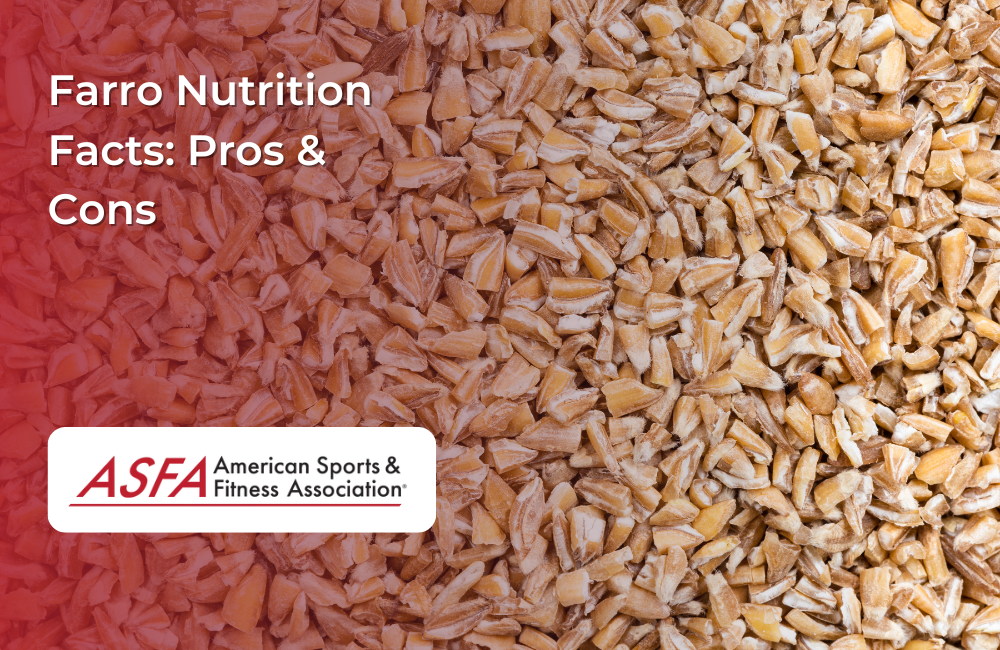Farro is a nutrient-dense ancient grain that is packed with fiber, protein, and essential vitamins and minerals. It is commonly used in soups, salads, grain bowls, and risottos. While farro offers numerous health benefits, it contains gluten and is relatively high in carbohydrates, which may not be suitable for all diets.
Farro Nutrition Facts Pros Cons: A Comprehensive Nutritional Profile
One 1-cup (170 grams) cooked serving of farro, a whole wheat grain, provides numerous nutritional benefits. Farro is known for its high fiber and protein content, making it a popular choice among those seeking healthy grain alternatives. It offers:
-
Calories: 200-220
-
Carbohydrates: 45-50 grams
-
Dietary fiber: 5-8 grams, which is crucial for reducing the risk of chronic diseases and improving digestion
-
Protein: 6-8 grams
-
Fat: 1-2 grams
-
Sugar: 0 grams
-
Vitamins and Minerals:
-
Iron: Supports oxygen transport in the blood
-
Magnesium: Helps with muscle and nerve function
-
Zinc: Supports immune health and metabolism
-
B Vitamins (Niacin, Riboflavin, B6): Aid in energy production and brain health
-
Antioxidants: Contains polyphenols that help reduce inflammation
Pros of Eating Farro
High in Fiber for Digestive Health with Whole Grain Farro
-
5-8 grams of dietary fiber per serving promotes regular bowel movements, improves digestion, and supports gut health, reducing the risk of chronic diseases such as diabetes and cardiovascular disease.
-
Supports weight management by increasing satiety and reducing hunger.
Good Source of Plant-Based Protein
-
6-8 grams of protein per cup, making it a great plant-based protein source.
-
Contains essential amino acids, which are crucial for muscle growth and muscle recovery.
-
Helps support muscle growth and recovery.
Rich in Complex Carbohydrates for Energy
-
Provides slow-digesting, whole-grain carbs, which supply long-lasting energy. Farro has a low glycemic index, which means it releases glucose more slowly and steadily, providing long-lasting energy.
-
Great for athletes and active individuals needing sustained fuel.
Packed with Vitamins and Minerals as an Ancient Grain
-
Iron, magnesium, and B vitamins support energy production and the immune system.
-
Zinc and antioxidants help reduce inflammation and improve overall health.
-
Farro, also known as emmer wheat, is an ancient wheat grain rich in fiber and protein, making it a nutritious whole-grain alternative.
May Support Heart Health
-
High fiber content helps lower cholesterol levels.
-
Whole grains like farro are linked to a reduced risk of heart disease.
Versatile and Easy to Use
-
Can be used in soups, salads, grain bowls, risottos, and as a side dish.
-
Nutty, chewy texture enhances meals without overpowering flavors.
-
Cooked farro can be used in salads, stir-fries, and side dishes. It can be prepped in advance and stored in the refrigerator for up to a week, making it a convenient ingredient for quick and healthy meal prep.
Cons of Eating Farro
Contains Gluten
-
Not suitable for people with celiac disease or gluten sensitivity.
-
Spelt and emmer wheat, also known as farro, contain less gluten than modern wheat but still have some.
High in Carbohydrates
-
45-50 grams of carbs per serving, which may not be ideal for low-carb or keto diets.
-
Diabetics should monitor portions to avoid blood sugar spikes.
May Cause Digestive Discomfort
-
High fiber content may cause bloating or gas if consumed in large amounts.
-
Those with IBS or sensitive digestion should introduce it gradually.
Takes Longer to Cook
-
Whole farro takes up to 40 minutes to cook, but semi-pearled farro, which has some of the bran removed, cooks faster. Pearled farro also cooks quicker than whole farro.
Conclusion
Farro is a high-fiber, protein-rich ancient grain that provides long-lasting energy, essential nutrients, and heart-health benefits. However, it contains gluten, is relatively high in carbs, and may cause bloating in some individuals. Choosing whole-grain farro and consuming it in moderation ensures the best health benefits.
FAQs
Is farro healthier than rice?
Yes, farro has more fiber, protein, and micronutrients than white rice and even some brown rice varieties.
Is farro good for weight loss?
Yes, its high fiber and protein content promote satiety and maintaining a healthy body weight. Incorporating whole grains like farro can help achieve this.
Can diabetics eat farro?
Yes, but in moderation, as it is high in carbohydrates. Pairing it with protein and healthy fats can help regulate blood sugar.
Is farro gluten-free for Celiac Disease?
No, farro contains gluten, making it unsuitable for those with celiac disease.
How does farro taste?
It has a nutty, chewy texture, similar to barley or brown rice.
What’s the best way to cook farro?
Simmer 1 cup of farro with 2.5-3 cups of water or broth for 30-40 minutes (less for semi-pearled varieties). When cooking farro, it's important to select the right cooking liquid. Water is a basic option, but using broth can add extra flavor. Additionally, choose the appropriate type of farro: whole farro takes longer to cook, while semi-pearled and pearled varieties require less time.
Can I eat farro every day?
Yes, in moderation, as part of a balanced diet.
Is farro better than quinoa?
Quinoa is gluten-free and higher in protein, containing all nine essential amino acids, while farro is higher in fiber and minerals. Both are healthy options depending on dietary needs.





